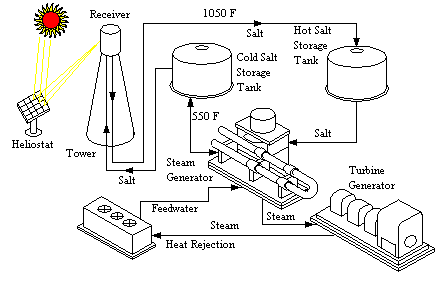 In Granada- Spain, German scientists of Solar Millennium AG, have developed a solar-thermal power plant called Andasol 1. The most interesting thing about this power plant is that it can produce energy even when the sun is not shining: at night, on clouding or even rainy days.
In Granada- Spain, German scientists of Solar Millennium AG, have developed a solar-thermal power plant called Andasol 1. The most interesting thing about this power plant is that it can produce energy even when the sun is not shining: at night, on clouding or even rainy days.
Salt is a key element that is used in Andasol 1. Most salts have very high melting temperatures and do not turn to vapor until they are considerably hotter. Table salt has the melting point at 1452 degrees Fahrenheit or 800 degrees Celsius. So it can easily be used to store heat from the sun.
Salt allows the power plant to run at full capacity of 50 MW for almost 8 hours after the sunset.
The molted salt technology is very simple in theory. The molted salt has 60% sodium nitrate and 40% potassium-nitrate. The salt melts at 430 Fahrenheit and is kept liquid at 550 Fahrenheit in an insulated cold storage tank. The molted salt is pumped to the top of the tower, where sunlight heats it in a receiver to 1050 degrees Fahrenheit. The 1050 F heated salt flows back down to a second insulated hot storage tank. Hot salt goes into a steam generator which produces very hot steam for a turbine.

Molted salt technology is almost 93% efficient compared to directly harvesting the sun energy. The other 7% lost during the heat transfer to water is not so significant if we compare to other technologies of storing the energy that comes from the sun.
Andasol 1 is the first solar-thermal power plant ever built, and the investments costs go up to $380 million (300 million euros).
Solar Millennium is very confident the technology will work so it already started to built the second solar-thermal power plant, Andasol 2. The second power plant will be fully functional by May – June this year.
When it comes to energy, U.S. always have future plans. So now they plan to built a 280-megawatt solar-thermal power plant called Solana, southwest of Phoenix on nearly 2,000 acres (800 hectares) of land.
Even if Andasol and Solana are very efficient power plants, they don’t capture as much of the sun’s heat as is possible. The synthetic oils used to capture the sun’s heat begin to break down above 750 degrees Fahrenheit (400 degrees Celsius), but the molten salts can take in much more heat than that. Increased salt temperature means increased power efficiency.
 A company called Solar Reserve in Santa Monica, California, developed a power tower to get the salts to a higher temperature. The tower has a vast mirror structure that concentrates sunlight so molten salts go to a higher temperature.
A company called Solar Reserve in Santa Monica, California, developed a power tower to get the salts to a higher temperature. The tower has a vast mirror structure that concentrates sunlight so molten salts go to a higher temperature.
Now researches Solar Millennium are looking to develop a salt that could be used instead of the oil in parabolic trough power plants, that melts at lower temperatures and would not freeze during cold nights. The new salt that was developed until now melts below 212 degrees Fahrenheit (100 degrees Celsius).
Will this be the future of the solar farms, to be transformed into solar-thermal power plants? Would they be more efficient?


































This sound almost too good to be true. I’m a little skeptical about producing solar energy in night time – in theory it is possible, but in real life I don’t know if it can be made with the current technology.
I hear that the US govenment approved 754MW of solar projects planned for public land in California. Its a great use of land knowing electricity produced in done through photovoltaics.
Hey Solar Man, Hey Acnerdy, recently I read an article saying that Japanese who have installed solar panels on their roof tops are now selling energy to the government as they are producing far more than they are consuming. I think very soon the world will switch to solar power all over the world.
the cost of Solar Cells for Solar Energy utilization has been decreasing over the past years. pretty soon, solar energy would be a more viable alternative than fossil fuels.
Solar thermal energy seems to be gaining in popularity. Spain are planning 60 new plants. And Australia want it to be their main source of energy by 2050